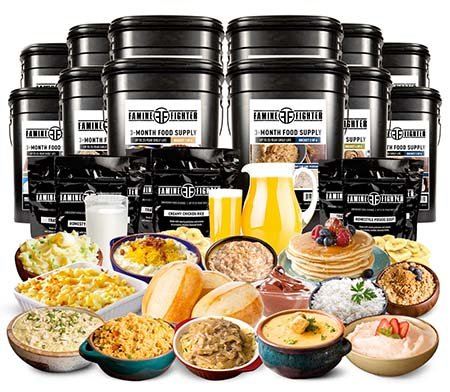Buy Famine Fighter Emergency Food: Creating an emergency food supply specifically tailored for prolonged periods or scenarios resembling famine requires careful planning and consideration of nutritional density, longevity, and sustainability. Here’s a detailed guide on what to include in a “Famine Fighter” emergency food supply:
Key Considerations:
- Nutritional Density: Prioritize foods that are rich in essential nutrients like protein, carbohydrates, fats, vitamins, and minerals to sustain health over an extended period.
- Long Shelf Life: Choose items with a long shelf life to minimize the need for frequent rotation and ensure they remain edible for an extended period without refrigeration.
- Caloric Density: Select foods that are calorie-dense to provide sufficient energy for daily needs, especially in situations where food scarcity is prolonged.
- Storage Space: Consider the amount of storage space available and choose items that are compact and easy to store.
- Water: Ensure you have an adequate supply of water stored alongside your food supplies.
Foods to Include:
- Grains and Legumes:
- Rice: White or brown rice in bulk.
- Beans and Lentils: Dried beans and lentils for protein and fiber.
- Quinoa: High in protein and versatile.
- Canned and Preserved Foods:
- Canned Meats: Such as tuna, chicken, or spam for protein.
- Canned Vegetables: Variety of vegetables like corn, peas, and carrots for nutrients.
- Canned Fruits: Provide vitamins and natural sugars.
- Dried Foods:
- Dried Fruits and Vegetables: Provide vitamins and minerals.
- Dried Beans and Legumes: Lightweight and high in protein.
- Jerky: Dried meat for protein and longer shelf life.
- Nutrient-Dense Foods:
- Nut Butters: Peanut butter or almond butter for protein and healthy fats.
- Nuts and Seeds: High-calorie content and good source of fats and protein.
- Trail Mix: Combine nuts, dried fruits, and seeds for a calorie-dense snack.
- Staples and Additives:
- Salt and Spices: Enhance flavor and provide essential minerals.
- Sugar or Honey: Provide quick energy and sweetness.
- Cooking Oil: Small bottles of vegetable oil or olive oil.
- Ready-to-Eat Meals:
- Meal Replacement Bars: High-calorie bars fortified with vitamins and minerals.
- Instant Noodles or Pasta: Quick to prepare and provide carbohydrates.
- Instant Soups: Provide warmth and nutrients.
Quantity Considerations:
- Calculate Needs: Base quantities on the number of people in your household and estimate daily caloric needs (about 2,000-2,500 calories per person per day).
- Duration: Aim to have enough food for several weeks to months, depending on the potential duration of the emergency.
Additional Considerations:
- Medical and Dietary Needs: Consider any special dietary requirements or allergies within your household when selecting emergency foods.
- Tools and Utensils: Include a manual can opener, utensils, and portable stove or heating method if possible.
- Rotation and Storage: Check expiration dates periodically and rotate items to maintain freshness. Store in a cool, dry place away from sunlight.
By carefully planning and stocking your “Famine Fighter” emergency food supply with nutrient-dense, shelf-stable foods, you can better prepare for prolonged emergencies or crises where food scarcity may be a concern. Regularly review and update your supplies to ensure readiness and effectiveness.
Pricing:
Famine Fighter Survival Food is a product that provides a 3-month to 1-year supply of food (depending on the package) designed to sustain individuals during times of famine or crisis.
Secure Your Reserved Famine Fighter Survival Food While Stocks Last






